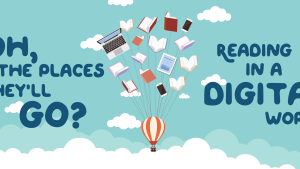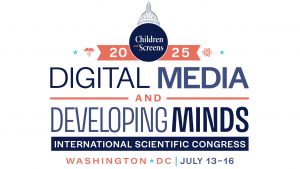
Even before the COVID-19 pandemic necessitated a shift to online learning, children’s reading habits were growing increasingly digital, with laptops, chromebooks and tablets replacing books and magazines in many households. Decades of studies show that the manifold advantages of printed material.
While e-books and online reading present convenient options with distinct affordances, they can also pose challenges of distraction and misinformation. However, that doesn’t mean digital text can’t have a place in children’s lives, and there are in fact a variety of ways that its use can complement traditional books when it comes to education and development. Getting that balance right can seem like a daunting task for parents, who frequently feel left in the dark when it comes to understanding pros and cons of printed material versus digital books. With that in mind, some of the leading figures in the fields of reading, literacy, pediatrics, education, psychology, and parenting have weighed in with answers to many of the most common questions about reading and literacy in our increasingly digital world.
Do Children Comprehend What They’re Reading Better With Printed Material?
While there are a number of factors that come into play when addressing this question, the short answer is that studies seem to consistently show that children comprehend informational texts better when they’re printed on paper. “In a review of the research on reading in print and digitally, my co-author and I found that no matter the child’s age, readers comprehend better when reading in print,” says Lauren Singer Trakhman, an Assistant Clinical Professor in the Department of Human Development and Quantitative Methodology at the University of Maryland, College Park. “The only time that there weren’t significant differences in comprehension across mediums was when only the main idea or a gist understanding was needed. If you’re only reading to understand the gist of an article, either reading in print or digitally is fine. But if you are reading for deeper meaning, you and your children, no matter their age, should be reading in print.”
Most existing studies on reading comprehension tend to focus on young adults rather than young children, cautions Anne Mangen, PhD, professor at The Norwegian Reading Center at the University of Stavanger in Norway. “However, we did a mode-effect study of 5th graders in Norway who took two comparable reading comprehension tests, one on paper and the other one digitally. On average, all students performed better on paper, both boys and girls, and across all performance levels (low-, medium- and high-achieving students).”
Do Children Read Differently When Reading In Print Than When Reading On Screens?
Yes and no! “Many of the basic word reading and comprehension processes are the same when reading digitally and in print,” says Amanda P. Goodwin, Associate Professor at Vanderbilt University and Editor of Reading Research Quarterly. “In both cases, children identify words and put meanings together into larger sentence and text-level units.” However, in a recent study, Goodwin and her colleagues found that students were more likely to highlight a greater proportion of the important content when reading digitally, which actually supported their comprehension. “Here, parents can encourage their children to be thoughtful when highlighting and to highlight just the important parts of the text,” says Goodwin, “as highlighting large amounts of texts, which happens more often with paper, isn’t as helpful.”
Another way to think about how children read differently on screen is to recognize that there can be tools embedded in digital reading materials that affect their reading, for good and bad. For example, a book on screen can include a quick quiz that tests comprehension or a pop-up dictionary definition for a tricky word. In their book Tap, Click, Read: Growing Readers in a World of Screens, Lisa Guernsey and Michael H. Levine write about a study led by Daisy Smeets and Adriana Bus of Leiden University in the Netherlands that tackled this issue. It showed that kindergartners reading electronic storybooks learned more vocabulary when they answered quick questions while reading or directly thereafter. Other studies, however, have shown that pop-ups can distract a child from a story if the pop-ups are nothing more than bells and whistles, unrelated to the content the story is trying to convey. If using e-books, parents and educators should seek out the ones that have purposeful moments of interaction, instead of distractions.
Are There Times When Digital Texts Can Be As Effective For Comprehension As Printed Text?
“Our work and others suggest that for short texts, children learn equal amounts when reading digitally or in print,” says Goodwin. “This means that when your child is reading texts that fit on one screen or slightly more, the learning is pretty similar regardless of mode. But for longer texts, children seem to comprehend paper texts better than digital texts. This may be because kids get used to the shallow processing expected in digital texts or have challenges mapping content onto specific locations in the text because of scrolling.” When reading digitally, Goodwin recommends that parents encourage children to interact and process the text deeply rather than skimming, and to map important ideas on fixed places in the text like images or headings.
“There are times when digital texts can be as or even more effective at supporting comprehension than printed text,” adds Rebecca Silverman, Associate Professor of Early Literacy at Stanford Graduate School of Education. “When digital texts have support for understanding new words or new content that children may not know, digital texts can provide brief video, audio, or textual support that can enhance comprehension. For example, if a child is reading a book and doesn’t know what it means to decompose, a brief time-lapse video or interactives showing the decomposition of fruit along with an audio explanation can be much more clarifying than figuring out the word from context or even having access to a printed definition and static picture. These affordances of digital texts, if well-designed to support rather than detract from comprehension, can render digital texts more effective than printed texts, in some cases.”
What Are The Advantages Of Print Books Over Digital Books?
“Print books are ideal for children because they’re simple and require the child and/or caregiver to actively participate in reading,” says John Hutton, MD MS FAAP, Assistant Professor of General and Community Pediatrics and Director of the Reading and Literacy Discovery Center at Cincinnati Children’s Hospital Medical Center. “They’re perfect catalysts for sitting close together free of digital distraction, asking and answering questions, and reflecting on the characters and story. Children’s books provide ‘scaffolding’ that evolves with age, with more pictures and chunky pages for youngest children, progressively longer text as they get older, and then with no pictures once the child can visualize scenes on their own and sustain attention for progressively longer books.”
According to Silverman, “There are some indications that children have more engaged conversations about books when reading print versus digital texts with parents or peers. We’re not really sure why this is. It could be that parents and children feel more control over the reading experience of books and are more passive when engaging with digital texts. However, it could be that parents and children will adapt to reading digital texts more naturally over time or as a function of advice which suggests that parents and children should remain engaged and active readers regardless of text type. More research is needed in this area.”
What Are The Disadvantages Of Print Books Over Digital Books?
“Digital books are lighter, quicker to purchase, and don’t tear,” says Hutton, “and you can fit a nearly infinite library on a single device. However, I would argue that print books don’t run out of batteries, get viruses, or crash, and a nearly infinite amount of non-book, oft-distracting content can also fit on a single device. It’s safe to say that all children you see reading books are reading books, while most children you see gazing into devices are playing games, browsing YouTube or TikTok or on social media. Neither format is particularly good in the rain, pool or bathtub.”
“Digital media—whether e-books or other types of digital texts—also have the advantage of being adaptable, interactive, and update-able,” says Lisa Guernsey, director of Teaching, Learning, and Tech at New America. “In other words, they can change with the times. For example, Guernsey says, “you may want to give your kids the opportunity to read and learn about U.S. history based on new narratives and a diverse array of voices—perspectives not often reflected in conventional textbooks of decades ago. Materials such as textbooks or short passages used as prompts in lesson plans can be updated much more easily in a digital format, making way for perspectives that are relevant, culturally responsive, and more engaging for today’s learners.”
“Being able to access texts on digital applications and platforms can provide children with a much wider selection than most children would have access to,” adds Silverman. If children are interested in dogs, they can search for books on dogs and bring up a wide variety of options from narratives to information books to comics and more. Because of the wider selection, children may be able to follow their interests more readily and thereby be motivated to read more. “Especially in the current era when it is difficult to get books from libraries,” he continues, “providing children with access to a wide selection of books, often at much less cost than purchasing print versions, may help with their engagement in literacy. Often the access to a wider selection of texts than one typically has in a home library or even at the public library can also mean that children are able to access more texts with a wide range of content as well as linguistic and cultural perspectives and representation. Seeing oneself in books and learning about others from books is critical in this time of increased stress and isolation.”
What Are The Advantages And Disadvantages Of Digital Books With Additional Features Like Dictionaries And Games?
Digital devices make it convenient to quickly gather information, but that ease of use can also result in unhelpful distraction. “Children, like the rest of us, need to guard against going down the internet rabbit hole of following links unrelated to what they’re reading,” says Naomi S. Baron, author and Professor Emerita of Linguistics at American University in Washington, DC. “Built-in dictionary programs can be expedient, but unless you write the word down and try to remember its meaning, just seeing the definition online probably won’t stick.”
It’s important for parents to consider the big picture when it comes to the pluses and minuses of digital books. While some benefit from the ability to encourage children to create and imagine their own stories while they read, many are of low quality and contain features that can overwhelm young readers. “E-books with distracting mini-games or sounds that are not aligned with the storyline can impede children’s story comprehension,” says Professor Natalia Kucirkova of the University of Stavanger and The Open University. “Additionally, in-built dictionaries work for vocabulary learning, but not for meaning-making. And while some personalized e-books are great fun, they may also collect personal data for commercial and marketing purposes.”
Well-designed storybooks may hold the potential to support readers as they practice and develop their reading skills. “The flexibility and malleability of electronic text allows for the adjustment and selection of digital features to suit the skills and preferences, of each child,” says Mirit Barzillai, Ph.D. “For example, access to multimodal definitions and multimedia congruent with the story can enhance story comprehension, particularly among children with limited vocabularies and second language learners, while children with fluency difficulties may benefit from text that is highlighted as it is read. Similarly, the inclusion of digital games that focus on the phonological or othrographic properties of words can foster word knowledge among beginning or struggling readers. Other children, however, may find them distracting. Understanding their child’s reading skills and literacy goals will allow parents to make informed decisions about which technological affordances will be most advantageous.”
“It is important to recognize that not all digital books are the same,” says Silverman. “Parents should evaluate the affordances and drawbacks of individual digital book applications and platforms. And, these may depend on the age, background, and language of the children. Affordances of some digital book platforms and applications include providing definitions and translations of words. These tools can be especially helpful when used by parents or children in the moment to help clarify word meanings or support comprehension. Enhanced features such as visuals or interactives that help explain words or concepts or text to speech and audio translation can be particularly helpful when new words or concepts are introduced. However, when they pop up automatically and provide tangential information, they can get in the way of meaning making. Parents really need to weigh the pros and cons of each digital book application or platform on its own merits and on what would be most supportive of their children.”
When Should Children Begin Reading Online, And How Can Parents Prepare Them For What They’ll Find?
According to Baron, the age at which children start reading online is less important than the preparation parents give them in the years leading up to it. “One important lesson is to explain that people tend to be less careful (and more distracted) when reading digitally than when reading in print,” says Baron. “Reading casual things online is OK, but if we want to understand and remember what we’re reading, either try for print or be aware of the need to really focus when reading on screen.” Baron also recommends helping children learn to recognize sensationalism and falsehoods, which run rampant online.
“It’s important to limit screen time for young children, but it’s equally important to help children learn to navigate digital texts, which are different from print-based texts in many ways,” says Kristen Hawley Turner, Professor of Education at Drew University in New Jersey. “We cannot expect young readers to transfer their skills of reading print books to a screen without modeling our own reading and supporting their comprehension. As parents read on their devices, they can ‘think out loud’ about what they’re reading and how they’re interacting with the content. This kind of modeling can start from an early age. Rather than children seeing their parents scrolling mindlessly, they can begin to think about what’s on the screen as something to be read.”
Does Reading On A Digital Device Impact Attention Or Executive Function Development?
“This depends on the level of ‘task-switching,’ required,” says Hutton. “There are two main attention networks in the brain, one for focus and the other for redirection, or switching. Paper stories or books are inherently less distraction-prone and require more sustained focus, where switching is relatively fluid and involves imagination, emotion, static pictures (if a picture book), and language. Many e-books or apps for children have ‘enhanced’ features such as animation and sound effects that add often fast-paced, highly visual stimuli that can overload processing capacity, especially at younger ages. There is also evidence that children can have a hard time reorienting from highly stimulating visual tasks to more immersive tasks such as book reading or creative play.”
How Can Parents Mitigate Reading Losses Due To School Closures And Loss Of Childcare During The Pandemic?
“It’s often overlooked that AAP guidelines not only mention limits on screen time, but encourage healthy, age-appropriate, non-screen alternatives,” says Hutton. “While screen time has increased dramatically during COVID, the best way to mitigate reading loss is to make time for reading via consistent, fun reading routines. This might include setting aside 30 minutes for book sharing at bedtime for younger children, encouraging kids to pick certain books to read every day with goals akin to a ‘COVID Book Club,’ and/or going to the library to get new books for the child to read. Despite its many negatives, COVID offers an opportunity for families to try these kinds of ‘old-school’ activities at home.”
Should Parents Be Co-reading More With Their Children On Digital Books Or Print Books?
Co-reading with children is a great activity, regardless of the medium. “It’s easier and more fun to read a physical book, but any form of co-reading creates a strong bond between parent and child as they discover the magic and mystery of new lands and new information,” says Rayna Dineen, founder and Executive Director of Reading Quest. “It’s helpful to welcome questions and conversations about what you’re reading, even if it takes you away from the book for a while. If a child struggles with five or more words on a page, that book might be too hard for the child to read alone, but it could be just the right book for shared reading. When an adult models reading with expression, letting punctuation guide phrasing, the child starts to pick up those great habits as well. Patience is most important as children learn to sound out words.”
“Whenever you or your child begin a reading task, you should consider the purpose,” says Trakhman. “Is it for pleasure? If so, reading in print or digitally will work. Do you need to understand it deeply for an important meeting or exam? In this case, I would suggest reading in print. For co-reading, the most important thing is that your child is engaged and excited about the task, so whichever medium works better for your child is how you should be co-reading. However, I would suggest explaining to your child why you’re reading in print or digitally (i.e., ‘we are reading just for fun tonight, so let’s read an e-book!’) so they can learn the metacognitive skills to select the appropriate medium for reading tasks.”
“We live in a both/and world,” says Turner. “Reading is both print and digital. Rather than being concerned about the introduction of more digital texts, we need to accept that our children must learn to navigate more traditional reading material alongside digital reading. It’s well documented in research that parents reading alongside their children in early years helps to develop young readers. Children whose parents read to them have a head start in literacy. Similarly, children whose parents sit with them while they navigate the internet will have a head start in developing digital literacy.”
For very young children, the language and literacy benefits of early shared print-reading are enormous. “Nestled with their parents around an open book, undisturbed by the constant need to click, shared reading becomes an intimate time of language exposure and story immersion, where parents encourage their children to expand, infer, predict, and connect the text to their own lives,” says Barzillai. “ These interactions enrich children’s literacy skills, while also shaping their view of reading as an activity deserving of deep attention and thought. When reading digital texts, with their panoply of highly engaging features, parent-child conversations tend to shift to the mechanics of, and the behavior surrounding, the electronic book. Digital books with “read to me” options, may even signal to parents that they are not needed when children read. Parental support, however, is key to not only help children stay focused and learn to navigate digital texts, but also to encourage them to engage in meaningful conversations around the story.
Should Parents Of High School Students Insist On Print Textbooks For Their Kids?
All the current research concludes that print is better for reading where in-depth understanding counts. “The evidence piles up about reading longer texts, remembering details, making inferences, dealing with abstractions, and knowing where in the story an event happens,” says Baron. “Students themselves report they concentrate and remember best with print.” With schools moving to increasingly digital textbooks, parents should speak with teachers, librarians, and administrators about the importance of print to reading comprehension or seek out print copies of books on their own, if necessary. “When digital is the book’s only format, it’s critical we teach students to apply a learning mindset to their onscreen reading,” says Baron. “Encourage them to slow down, avoid multitasking, reread what they don’t understand, and stop and think about what they’ve read.”
How Can Parents Inspire A Love Of Reading In Their Children?
The easiest way to inspire a love of reading is to be a good role model. “If your children are aware that you gain enjoyment and pleasure from books, music, art, etc., then they’ll emulate your example, both online and off,” says Dr. Julia Gillen, Professor of Literacy Studies and Director at Lancaster University’s Lancaster Literacy Research Centre. “Accessing the internet in meaningful ways (for example, to find information about a plant when you’re walking outside, gardening, or painting together) will also help kids learn to appreciate such purposeful use, entwined with other activities.”
There are lots of ways to show your kids how much you love to read. “Spend time in the library together and talk with librarians about books,” says Mangen. “Spend time reading together, both co-reading the same book and each reading your own. Have books readily available throughout your home so that they’re visible and it’s easy to pick one up at any time.”
A child’s love of books really takes off when they find that “just right” book that brings magic into their lives or explains a topic that they’re passionate about. “Giving students the choice of what they’re reading, or what you’re reading to them, is crucial,” says Dineen. “Listening to books read aloud inspires a love of books and builds vocabulary, comprehension, and knowledge. Reading with expression, using different voices, and pointing to pictures makes books come alive. When a child finds a book that they’re naturally interested in, let them read it – even if it’s the 35th book about trains this year. Graphic novels are also powerful tools for getting kids, especially reluctant readers, into the reading habit. Taking books with you wherever you go also sends an important message about how vital books are. Don’t leave home without one!”
“We don’t want a ‘love of reading’ in our kids,” counters Marc Prensky, author of Education to Better Their World: Unleashing the Power of 21st-Century Kids. “We want a ‘love of getting useful and inspiring information — in whatever way they can receive it.’ Text will never go away, but its primacy ended when the 20th century did. If we had better ways for kids to find good print material about whatever they are specifically interested in—adjusted continuously to their growing level by tech—reading would not be a problem.”
If A Child Is Not A Strong Reader, Can Giving Them An E-Reader Be An Effective Tool?
“There are at least three major considerations,” says Hutton. “The first is the age of the child. Children with portable devices use more media, and it’s more difficult to oversee content, so I would discourage that under the age of eight. The second consideration is to what degree the content is ‘enhanced’ with things like animated features. These are common in e-books, but they tend to be distracting and can impair comprehension and imagination. In very limited doses (like reinforcing alphabet learning), this may be ok, but not in general. The third consideration is to what degree the parent is involved in sharing the stories. Parents can ask and answer questions, discuss ideas outside of the story, and provide emotional support with printed material in ways that aren’t possible with devices. This is particularly important for struggling readers.”
Can Games Help My Child Learn To Read?
The best thing parents can do is integrate reading into everyday life. Rather than frame it as a task, find ways, including games, to make it fun and engaging. “It’s important for families to take an interest in what their children are reading and playing,” says Gillen. “Parents can ask questions, play together for a while, and stimulate reading, writing, and drawing activities around games.”
What Kind Of Free/Affordable Options Are Out There For Families?
“There are many wonderful options for online book reading,” says Dineen. “For children using a computer (who also have a library card), these include Overdrive and Hoopla. Both are digital libraries with a huge selection of popular eBooks, graphic novels, chapter books, and audiobooks. Children who have access to Wi-Fi can also use these services on a phone or tablet. Many schools currently provide an account on EPIC, which is free for teachers. Once children have established an account at their school, they can access Epic at home as well. For children using a phone or tablet, Rivet is a free reading app with over 3,500 books. Reading online has its advantages as students can zoom in to enlarge words and click to learn the definition of new words.”
__________________
About Children and Screens
Since its inception in 2013, Children and Screens: Institute of Digital Media and Child Development, has become one of the nation’s leading non-profit organizations dedicated to advancing and supporting interdisciplinary scientific research, enhancing human capital in the field, informing and educating the public, and advocating for sound public policy for child health and wellness. For more information, see www.childrenandscreens.com or write to info@childrenandscreens.com.




